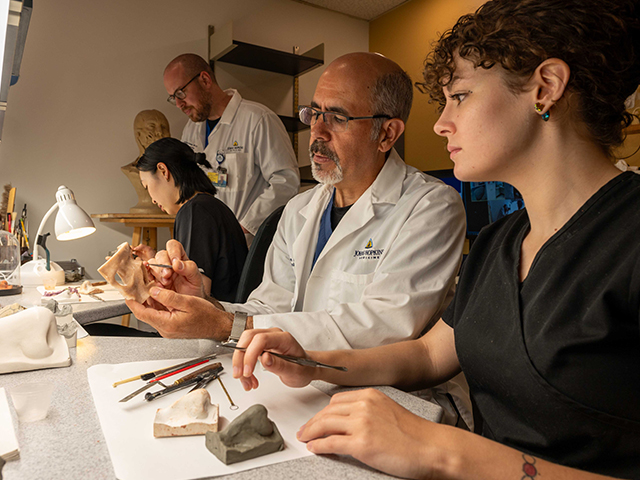Restored
By sculpting and painting prostheses for ears, noses, toes and more, clinical anaplastologists enable patients to go back out into the world feeling — and looking — whole.

Juan Garcia at work.
Photos by Mike Ciesielski
In a state-of-the-art lab in the 1830 Building on Monument Street, a prosthetic hazel eye sits on a plaster mold, encircled by a pinkish wax eyelid. Nearby are various shades of tinted silicone — from red to gold tones — that Juan Garcia (M.A. ’95) will use to meticulously cast an orbital prosthesis to best match the skin tones of the patient who will receive the prosthesis; it will replace an eye lost to a cancerous ulceration.
Garcia is a clinical anaplastologist — a rare kind of clinician who, along with his colleague Andrew Etheridge, sculpts and paints prostheses for ears, noses, hands, fingers, toes and feet in the Facial, Eye and Body Prosthetics Clinic at Johns Hopkins.

Above: In the 3D printing and visualization lab, Juan Garcia(L) and Andrew Etheridge(R) can 3D scan and print models using an advanced 3D printer that uses a resin material that is UV-cured by a laser, allowing for greater detail than traditional 3D printers. They can also access radiology data to create 3D models used in making prostheses. Using virtual reality technology, they can map out where implants are to be placed for surgeons — these magnetic or bar and clip systems can hold prostheses in place instead of adhesive. New technologies and facilities are being used by the clinical faculty and their graduate students to design and refine the art of making these prosthetic devices.
The clinic, part of the Department of Art as Applied to Medicine, serves patients who have experienced disfigurement from cancer, fire-related injury or work-related accidents, as well as those with congenital conditions. The silicone prostheses produced here help restore form and function, including normal breathing and being able to support eyeglasses. Crucially, the prostheses also give patients the confidence to go out in the world.
“We provide custom prostheses to help reintegrate patients and restore their normal social function,” says Garcia, the clinic director, who works closely with Johns Hopkins facial plastic surgeon Kofi Boahene.
The Johns Hopkins prosthetics clinic is among a small number in the country that perform this work — and the institution now has the distinction of hosting the world’s only Master of Science in Clinical Anaplastology graduate program. It fills a vital need: Currently there are only around 200 anaplastologists in the world, and more than half of the United States is not served by such a specialist, notes Garcia, a past president of the International Anaplastology Association.
In the Johns Hopkins program, students learn all aspects of anaplastology: human anatomy, anatomical sculpting, 3D technology, medical sculpting and modeling, and how to make the various types of prostheses, which are attached via adhesive or osseointegrated implants. Students finish with professional development, supervised clinical rotations and a capstone research project.
The program’s first graduate, Nicole Alderson (M.S. ’23), came to Johns Hopkins in 2021 with a bachelor’s in biology and a master’s of fine art in painting and sculpture. She previously worked at the Indiana University School of Dentistry, where she helped design facial prostheses. She says that anatomy was the most difficult course she’s ever taken but has proven to be invaluable in her work.
“How often in life do you get to dissect the area you’re working in?” Alderson says. “I’m constantly finding myself referencing those mental images — where nerves are, where to avoid and the direction of muscle fibers that determine how skin lays over the muscle that you’re trying to recreate or imitate.”

Alderson now works at an anaplastology practice in Milwaukee, and after nine months will open and run a satellite clinic in Indianapolis. In August, two more students started the 22-month program.
The master’s program is the successor to a supervised clinical training program Garcia started in 2009 that trained students to work alongside other clinicians in preparation for the Board of Certification for Clinical Anaplastology exam.
To learn his specialty, Garcia, who originally trained as a medical illustrator, traveled the country and the world to train with different specialists. With Johns Hopkins’ new degree program, all of that knowledge can be learned in-house.
“The International Anaplastology Association had a meeting before COVID in which they said, ‘We have to develop formal educational programs. Otherwise, access to qualified providers is going to remain limited,’” Garcia recalls. “Here, we have an opportunity to train the next generation of clinicians.”
See more photos in the online magazine: www.hopkinsmedicinemagazine.org
For more information, email medart-info@jhmi.edu.
